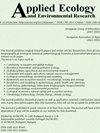FIRST DIVERSITY ASSESSMENT AND SYNTHETIC DYES REMEDIATION POTENTIAL OF AQUATIC MICROMYCETES FROM AIN SKHOUNA WETLAND, WESTERN STEPPE OF ALGERIA
IF 0.6
4区 环境科学与生态学
Q4 ECOLOGY
引用次数: 0
Abstract
. A first exploration of aquatic microfungal diversity was conducted in Ain Skhouna wetland, a part of Echott Ech Chergui (Algeria), the second largest chott in North Africa. Fungal strains isolation was carried out from water and sediment samples during 2019.Physico-chemical parameters (pH, temperature, and salinity)were measured in situ as well. Firstfungal strains identification wascarried out by cultural and structural features. A total of 14 monoclonal fungi strains belonging to 7 genera were distinguished where the majority of which belong to the phylum Ascomycota. Among these, the genus Halobyssothecium that was recorded for the first time in Algeria . Occurrence percentage frequency of different taxa showedhigher density of microfungal colonies in sediment compared to water. Through molecular barcoding successfully completed for 11 strains by Internal Transcribed Spacer (ITS) region sequencing, 5 strains were assigned to the species level and 6 to the Section or Complex within the correspondent genus. Authenticated strains based on ITS barcode were then screened for extracellular laccases production for mycoremediation assay, where 8 of them were laccases positive with strong activity exhibited by Aspergillus sp. AS02 and Penicillium sp. AS13 strains. All positive laccases strains were further investigated for their synthetic dyes decolorization ability using « Plate Volume Method » (PVM) to evaluate Congo Red, Brilliant Blue, and Malachite Green dyes decolorization activity at three concentrations, highlighting dyes biodegradation mechanisms used by each strain. Dyes decolorization seems more related to fungal laccases activity than biosorption or accumulation mechanisms. Aspergillus sp. AS02 and Penicillium sp. AS13 strains seem to be good dyes decolorizing candidates by biodegradation. Furthermore, Fusarium acuminatum AS07 showed significant biosorption activity, while Penicillium spp . generally expressed a good dyes accumulation potential. Therefore, identified and studied fungal strains could be used as promising tools for bioremediation of wastewater dyes and industrial effluents enclosing synthetic dyes.阿尔及利亚西部草原斯库纳湿地水生微真菌多样性评价及合成染料修复潜力
本文章由计算机程序翻译,如有差异,请以英文原文为准。
求助全文
约1分钟内获得全文
求助全文
来源期刊

Applied Ecology and Environmental Research
ECOLOGY-ENVIRONMENTAL SCIENCES
CiteScore
1.40
自引率
14.30%
发文量
104
审稿时长
14 months
期刊介绍:
The Journal publishes original research papers and review articles. Researchers from all countries are invited to publish pure or applied ecological, environmental, biogeographical, zoological, botanical, paleontological, biometrical-biomathematical and quantitative ecological or multidisciplinary agricultural research of international interest on its pages.
The focus is on topics such as:
-Community, ecosystem and global ecology-
Biometrics, theoretical- and quantitative ecology-
Multidisciplinary agricultural and environmental research-
Sustainable and organic agriculture, natural resource management-
Ecological methodology, monitoring and modeling-
Biodiversity and ecosystem research, microbiology, botany and zoology-
Biostatistics and modeling in epidemiology, public health and veterinary-
Earth history, paleontology, extinctions, biogeography, biogeochemistry-
Conservation biology, environmental protection-
Ecological economics, natural capital and ecosystem services-
Climatology, meteorology, climate change, climate-ecology.
The Journal publishes theoretical papers as well as application-oriented contributions and practical case studies. There is no bias with regard to taxon or geographical area. Purely descriptive papers (like only taxonomic lists) will not be accepted for publication.
 求助内容:
求助内容: 应助结果提醒方式:
应助结果提醒方式:


